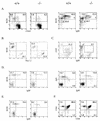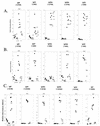Essential, nonredundant role for the phosphoinositide 3-kinase p110delta in signaling by the B-cell receptor complex
- PMID: 12446777
- PMCID: PMC139888
- DOI: 10.1128/MCB.22.24.8580-8591.2002
Essential, nonredundant role for the phosphoinositide 3-kinase p110delta in signaling by the B-cell receptor complex
Abstract
Many receptor and nonreceptor tyrosine kinases activate phosphoinositide 3-kinases (PI3Ks). To assess the role of the delta isoform of the p110 catalytic subunit of PI3Ks, we derived enzyme-deficient mice. The mice are viable but have decreased numbers of mature B cells, a block in pro-B-cell differentiation, and a B1 B-cell deficiency. Both immunoglobulin M receptor-induced Ca(2+) flux and proliferation in response to B-cell mitogens are attenuated. Immunoglobulin levels are decreased substantially. The ability to respond to T-cell-independent antigens is markedly reduced, and the ability to respond to T-cell-dependent antigens is completely eliminated. Germinal center formation in the spleen in response to antigen stimulation is disrupted. These results define a nonredundant signaling pathway(s) utilizing the delta isoform of p110 PI3K for the development and function of B cells.
Figures







Similar articles
-
Impaired B and T cell antigen receptor signaling in p110delta PI 3-kinase mutant mice.Science. 2002 Aug 9;297(5583):1031-4. doi: 10.1126/science.1073560. Epub 2002 Jul 18. Science. 2002. PMID: 12130661
-
B cell receptor signaling: picky about PI3Ks.Sci Signal. 2010 Aug 10;3(134):pe25. doi: 10.1126/scisignal.3134pe25. Sci Signal. 2010. PMID: 20699473 Review.
-
A crucial role for the p110delta subunit of phosphatidylinositol 3-kinase in B cell development and activation.J Exp Med. 2002 Sep 16;196(6):753-63. doi: 10.1084/jem.20020805. J Exp Med. 2002. PMID: 12235209 Free PMC article.
-
Attenuation of phosphoinositide 3-kinase δ signaling restrains autoimmune disease.J Autoimmun. 2012 Jun;38(4):381-91. doi: 10.1016/j.jaut.2012.04.001. Epub 2012 Apr 25. J Autoimmun. 2012. PMID: 22537464
-
The p110delta subunit of phosphoinositide 3-kinase is required for the lipopolysaccharide response of mouse B cells.Biochem Soc Trans. 2004 Nov;32(Pt 5):789-91. doi: 10.1042/BST0320789. Biochem Soc Trans. 2004. PMID: 15494016 Review.
Cited by
-
Targeting PI3K in Cancer: Any Good News?Front Oncol. 2013 May 8;3:108. doi: 10.3389/fonc.2013.00108. eCollection 2013. Front Oncol. 2013. PMID: 23658859 Free PMC article.
-
Emerging roles of class I PI3K inhibitors in modulating tumor microenvironment and immunity.Acta Pharmacol Sin. 2020 Nov;41(11):1395-1402. doi: 10.1038/s41401-020-00500-8. Epub 2020 Sep 16. Acta Pharmacol Sin. 2020. PMID: 32939035 Free PMC article. Review.
-
Distinct roles of phosphoinositide-3 kinase and phospholipase Cgamma2 in B-cell receptor-mediated signal transduction.Mol Cell Biol. 2006 Jan;26(1):88-99. doi: 10.1128/MCB.26.1.88-99.2006. Mol Cell Biol. 2006. PMID: 16354682 Free PMC article.
-
Phosphoinositide 3-kinase inhibitors in lymphoma.Curr Opin Oncol. 2014 Sep;26(5):469-75. doi: 10.1097/CCO.0000000000000113. Curr Opin Oncol. 2014. PMID: 25024054 Free PMC article. Review.
-
The PI3Kδ Inhibitor Idelalisib Inhibits Homing in an in Vitro and in Vivo Model of B ALL.Cancers (Basel). 2017 Sep 10;9(9):121. doi: 10.3390/cancers9090121. Cancers (Basel). 2017. PMID: 28891959 Free PMC article.
References
-
- Bi, L., I. Okabe, D. J. Bernard, and R. L. Nussbaum. 2002. Early embryonic lethality in mice deficient in the p110beta catalytic subunit of PI 3-kinase. Mamm. Genome 13:169-172. - PubMed
-
- Bi, L., I. Okabe, D. J. Bernard, A. Wynshaw-Boris, and R. L. Nussbaum. 1999. Proliferative defect and embryonic lethality in mice homozygous for a deletion in the p110alpha subunit of phosphoinositide 3-kinase. J. Biol. Chem. 274:10963-10968. - PubMed
-
- Cho, H., J. Mu, J. K. Kim, J. L. Thorvaldsen, Q. Chu, E. B. Crenshaw III, K. H. Kaestner, M. S. Bartolomei, G. I. Shulman, and M. J. Birnbaum. 2001. Insulin resistance and a diabetes mellitus-like syndrome in mice lacking the protein kinase Akt2 (PKB beta). Science 292:1728-1731. - PubMed
Publication types
MeSH terms
Substances
Grants and funding
LinkOut - more resources
Full Text Sources
Other Literature Sources
Molecular Biology Databases
Miscellaneous
